- Home
- Business Budget
- Building a Business Budget
Building a Business Budget
Here are tips for building a business budget so you can prepare your own budget.
You can prepare your budget on a piece of paper or in a spreadsheet program like Excel or Google sheets or whatever other you like.
There are APPS and software available for budgeting but we will not get into those here.
If you have Microsoft Excel you can do a search within Excel's templates for a pre-designed budget into which to type your budget estimates.
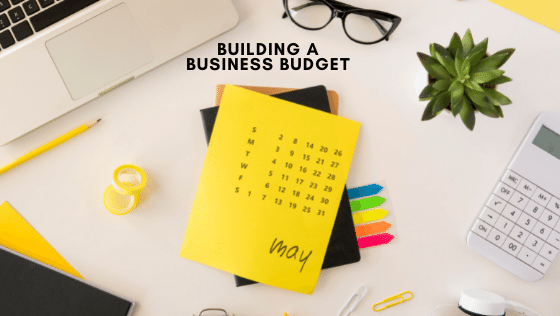
A budget is made up of a list of income and expenses.
When building a business budget, each income and expense type will be allocated an amount for one month.
The idea is that the business will keep within the allocated amount for the expenses no matter how many times they go to buy something within a month.
For example, in June the owner might visit a stationery shop on ten different days and make a purchase on each visit.
The goal of the budget is that those ten different purchases will not add up to more than the allocated total for Office Stationery for the month of June.
As you figure out your budget estimates, keep in mind that the allocated budget amount for each expense type should cover an accumulation of purchases in a month, and the income allocation will cover an accumulation of sales for the month.
The Source of Budget Expense Types
Now, you are most likely wondering how to go about choosing expense types, in other words how to name them.
Below is a list of category accounts which will give you some idea of possible income and expenses for your business.
Click on image below to open a downloadable PDF of this list.
When building the budget, the best idea is to pull together a list that matches expenses your business will likely see on its income statement or balance sheet.
These are the expenses specific to your business activities and which you are most likely to pay for to keep your business operating.
Using the same account categories found in your bookkeeping system makes it easier to do comparisons between budgeted allocations and actual expenditure found on your Reports.
preparing a list of budget categories
Building a Business Budget For Brand New Businesses
The first thing you will do is write or type a list of the categories you expect to occur in your business. You can use our categories list as a prompt.
You may want to just quickly get them all down as they come to mind in any order.
Then allocate as many estimated amounts as you can to each account, but if you need time to research about some of the estimates, leave them blank for now.
It also doesn’t matter if you include an expense on the list that only happens once a year or ends up never happening.
Include costs for any projects you are expecting later in the year, or seasonal income and expenses.
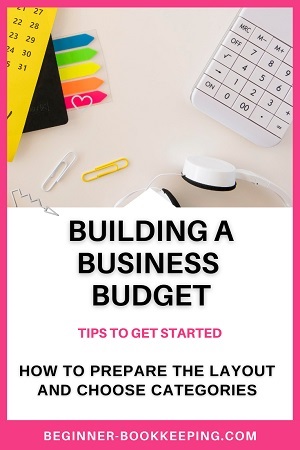
Building a Business Budget For Older Businesses
If your business has been operating for many months or even years already, you can use your existing income and expense categories off last year's Profit and Loss Report and Balance Sheet for each month, and include adjustments for inflation or price increases.
Below is an example of a starting list that isn't in alphabetical order. This is a short, simple example, but yours can be as long as it needs to be to cover all income and costs. This depicts somebody who has hand-written a list on paper but you can do yours in your spreadsheet software of choice.
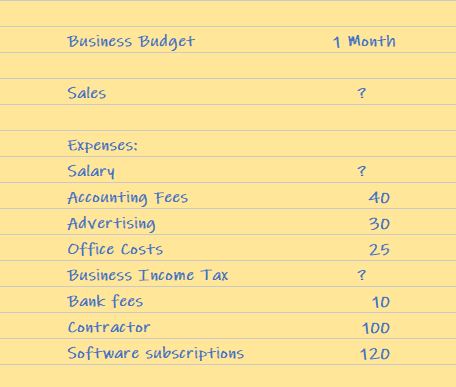 Building a Business Budget Starting List
Building a Business Budget Starting ListAfter this list is as complete as you can get it, put it into alphabetical order if not done already.
If you are unable to figure out what amount will be spent on any expenses, just give it your best guess.
As the months go by you will get a better idea of what the costs are and can adjust the budget sheet accordingly because it isn't a static spreadsheet that cannot be changed once made.
The sales amount can be allocated enough to cover the total of the costs - giving you the incentive you need to bring that amount into the business bank.
Here is the starting list now in alphabetical order with all amounts allocated.
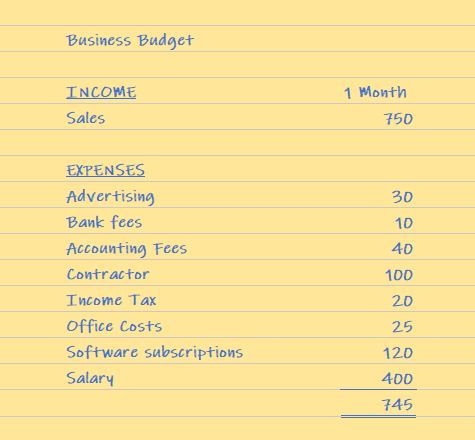 Building a Business Budget Alphabet Order
Building a Business Budget Alphabet Orderbuilding a Business Budget for 12 months
The next step is to lay out the budget in a sheet for all 12 months of the financial year - also called an annual budget.
There will be one column for the account names and 12 adjacent columns for all the months ahead.
The first section (first few rows) will be to display the estimated income.
The second section to display all the costs spread out into their appropriate months.
If your financial year starts in January, the first month of the budget will be January.
If your financial year starts in April, the first month of the budget should be April.
You must start with the first month of your particular financial year, or if you are starting part-way through the financial year then go with the month you started.
This exercise will be easier for a business that has been operating already for a year because you can take all the actual amounts from last year's Income Statement and Balance Sheet and use those as your foundation numbers for this 12 month forecast, but adjusted to include price changes or amounts for new projects you expect to happen.
Here is an example of a simple annual budget.
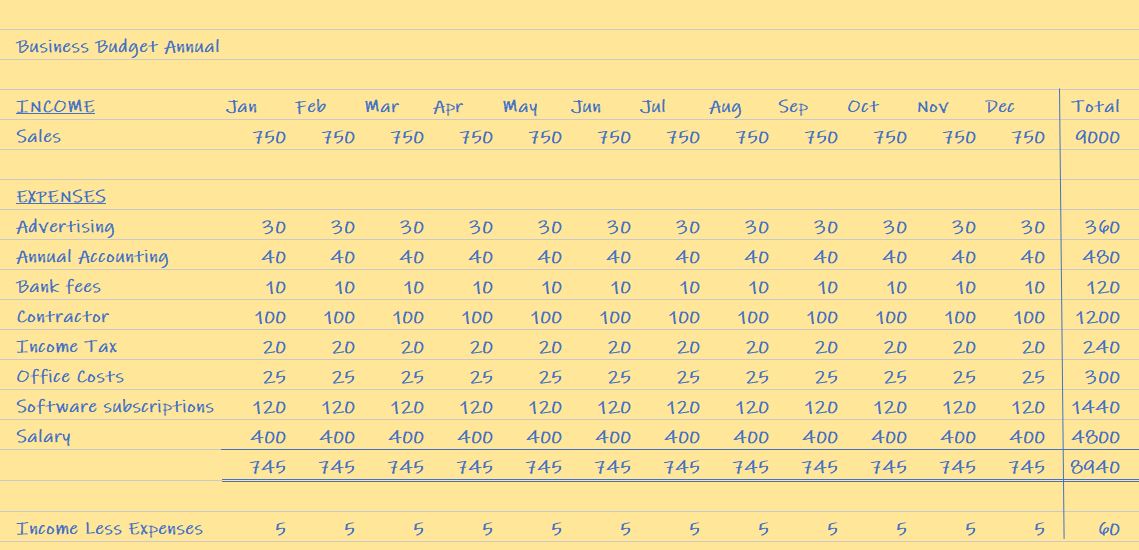 Building a Business Budget Annual Layout
Building a Business Budget Annual LayoutIn our above example, the amounts are exactly the same across every month.
In reality, you will be aware of costs that may be higher or lower at certain times of the year so your annual budget should reflect that.
If there are any months where an expense will not occur you can put a 0.00 or a dash or leave it blank.
what to do when you are finished building Your business budget
Well, if you’ve gone to all the trouble to build a budget you need to put it to good use!
A review and analyses of the actual costs vs the budgeted costs once a month is recommended.
- First, get your bookkeeping and reconciliations up to date for the month just finished
- Then prepare your profit and loss report and balance sheet for that month
- Then prepare a budget vs actual comparisons sheet.
One good way to do this is to include extra columns on your budget spreadsheet so you can slot in the 'actual' amounts, and the 'difference' between 'budget' and 'actual'.
This allows you to quickly see which expenses exceed the budget and which ones come within budget.
You could also add an extra column for each month to calculate the percentage increase or decrease of the actual amount compared with the budget.
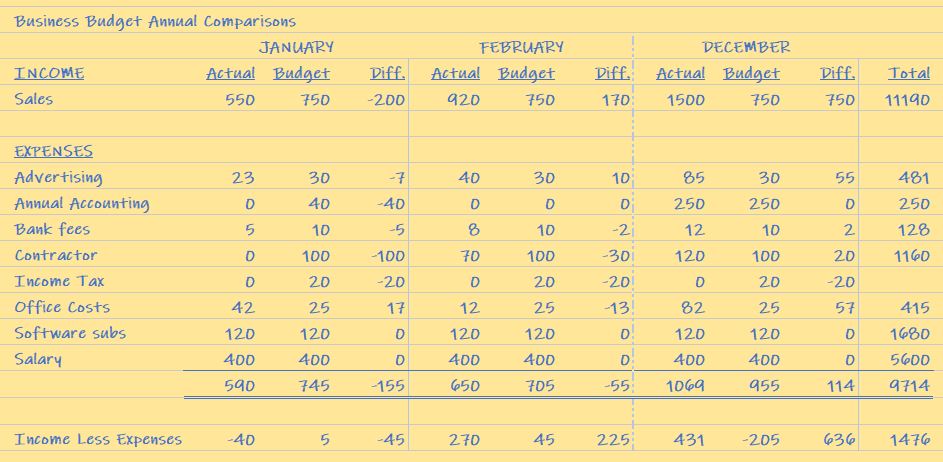
In the initial year of your business, there is no need to be stressed if the estimated budget figures are very different to the actual costs and earnings - unless money keeps running out and there isn’t enough to pay all the bills in which case you need to take urgent action to earn more, or do away with some expenses, or inject some of your personal money into the business.
Take this opportunity in the first year to get into the habit of checking on the budget regularly (at least once a month), comparing it with the actual costs to see how the money is tracking, and adjusting the budget such as including additional costs that you hadn’t thought of that weren’t on the budget in a previous month.
As you do your monthly reviews, you can work on ways to reduce expenses or do away with some altogether to keep total monthly spending within the planned budget.
This may require negotiating with current vendors and suppliers to reduce their charges, or finding new vendors who charge less, or ensuring there is no frivolous spending (looking at you business owner!).
Or it may prompt you to get creative with ideas for increasing your earnings.



